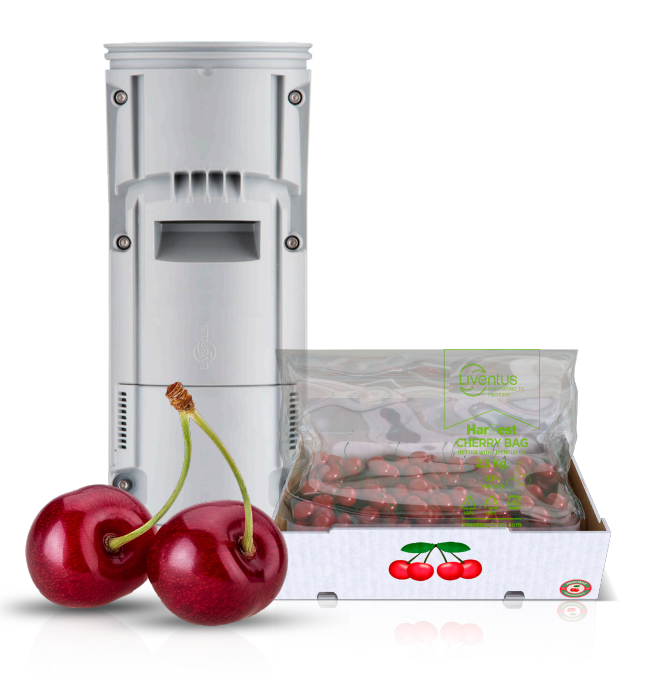Carbon Dioxide Permeability and the effect of Polyphenol Oxidase enzyme on cherries

By Liventus
The biggest limitation in the exportation of fresh fruit is time. Since the minute the fruit is separated from the tree, begins its senescence process, having an estimated period of days in which it must be processed, packed, exported and sold before it “dies”. Each day that passes, the fruit closer to suffer from different deterioration problems, which directly affect their price.
Each fresh product goes through a different deterioration process depending on what it is most sensitive to. For example, blueberries suffer from mycelium and loss of turgor due to dehydration, avocados suffer from lenticellosis and peduncular mold, while stone fruit suffer from mealiness and internal browning in the pulp.
Liventus Global, a company dedicated to providing integral and innovative post-harvest solutions to its exporters, manages to solve the main pains in both avocados and blueberries in the Chilean market, delaying the senescence process and achieving greater profitability at the time of sale, reaching 40% of the total controlled atmosphere market. This year, they found a new and disruptive solution to reduce internal browning in cherries: Liventus Full Control.
Internal browning is a condition problem that occurs in all stone fruits after a certain period of time, being cherries one of the most susceptible specie. Varieties like Regina usually express it 35 days after being harvested, as well as Lapins (a little less sensitive) which expresses it 40 days after being separated from the tree, but how does internal browning develop within the fruit and what does it depend on?
Although internal browning is part of the senescence of cherries, it is more exacerbated in fruit harvested overripe, mahogany red in color, with long storage times at low temperatures (below 7°C). These low temperatures modify the permeability of the cell membrane, disintegrating the pulp, causing a malfunction of the enzymatic activity, generating the oxidation of phenols thanks to the Polyphenol Oxidase enzyme. This problem is not only a visual problem by turning the flesh from a dark red color to a brownish-brown color, but it also directly affects the flavor, going from a sweet and sour fruit to a cherry with a flat and metallic flavor.
Today, there are few technologies that help reduce this problem in cherries, Liventus Full Control (LFC) being the most innovative and disruptive on the market. By combining their box-to-box HarBest bag with a small, ventilated area, they achieve all the benefits of high relative humidity, such as an excellent preservation of green pedicels and maintenance of firmness, coupled with the benefits of the Liventus Controlled Atmosphere that provide a high concentration of CO2 (over 10%) and O2 within an optimal range of action inside the container. All this, results in a decrease in the respiratory rate, high fungistatic control and most important of all, the inhibition of the Polyphenol Oxidase enzyme, hence reducing internal browning in the fruit.
It is not enough to simply apply a high concentration of carbon dioxide into the container to reduce internal browning, it is also necessary to ensure that these gases permeate inside the HarBest bag, managing to impact the fruit. After carried out different studies in conjunction with CEPOC (Post-Harvest Research Center of the University of Chile), Liventus was able to elucidate that gas concentration in the container and gas concentration inside its bag, box to box, is 1:1 , that is, the gases permeate perfectly inside the HarBest bags , having an effective CO2 concentration against internal browning both inside and outside the bag, as reflected in the graphs in figure 1.
Figure 1: Monitoring of gas concentration in the atmosphere mixer panel in the sack with bags of 0.028% ventilated area (B) and in the sack with bags of 0.056% ventilated area for Lapins variety cherries stored for 30 days at 0°C.
Source: CEPOC permeability study
Today we have few post-harvest technologies for cherries and none of them can solve internal browning. The only way to reduce the action of the polyphenol oxidase enzyme is through high concentrations of carbon dioxide, concentrations that cherries alone cannot reach in optimal temperature conditions. This can only be achieved by gas injection, just as the Liventus controlled atmosphere does. It’s of utmost importance to search and try new technologies that helps the industry solve the main problem of the cherry market.
For more information contact efernandez@liventusglobal.com












































